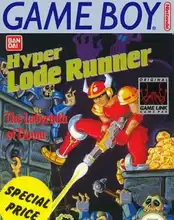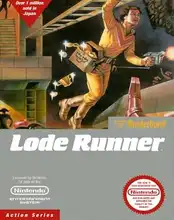Lode Runner: Digging Deep into a Retro Puzzle Classic
Remember the thrill of collecting glittering gold bars, the panic as pixelated guards chased you, and the satisfying 'thwack' of digging a temporary hole just in the nick of time? If you cut your teeth on early computer games, chances are you have fond memories of Lode Runner. More than just a simple puzzle-platformer, this 1983 gem by Doug Smith captured the hearts and minds of a generation with its clever design and, perhaps most importantly, its groundbreaking level editor.
Let's grab our digital shovels and take a nostalgic trip back to explore why Lode Runner remains a beloved classic.
What Exactly is Lode Runner?
At its core, Lode Runner is a 2D puzzle-platform game. The premise is simple: you control a lone hero tasked with collecting all the gold scattered throughout a single-screen level. Once every last bar is pocketed, a ladder appears, allowing you to escape to the next challenge.
Sounds easy, right? Not so fast. Standing between you and your shiny treasure are relentless guards who want nothing more than to catch you. You can't jump, you can't fight them directly, and getting caught means losing a life. This is where the game's unique mechanic comes in.
Digging Your Way to Victory: Gameplay Deep Dive
Your primary tool is your ability to dig holes in the brick platforms to your left or right. This isn't for mining (the gold is just there), but for strategic evasion and manipulation.
- Trapping Guards: Dig a hole, and if a guard walks into it, they're temporarily trapped. This gives you precious seconds to run past them, collect gold, or set up your next move.
- Collecting Gold: Sometimes gold is in places only a trapped guard can reach. A clever player might trap a guard carrying gold, wait for them to drop it, then collect it themselves.
- Creating Paths: Digging can also create temporary pathways or allow you to drop down through layers of bricks.
- The Danger: Be careful! If you get trapped in a hole as it refills, you lose a life. Guards who are trapped until the hole refills are 'killed' and respawn elsewhere, often near the top of the screen, which can sometimes work to your advantage or disadvantage.
Movement is limited to running left/right, climbing ladders up/down, and shuffling along hand-to-hand bars. Mastering the timing of digs, anticipating guard movements (which can sometimes be surprisingly unpredictable!), and planning your route are key to surviving the game's 150 challenging levels.
Beyond the Bricks: The Level Editor's Legacy
While the core gameplay was addictive, one feature truly set Lode Runner apart, especially for its time: the built-in level editor. This wasn't just a bonus; it was revolutionary. It empowered players to become creators, designing their own devious puzzles and sharing them with friends (usually via painstakingly typing out level codes or saving to floppy disks).
This editor not only extended the game's lifespan infinitely but also fostered a sense of community and creativity rarely seen before the internet age. It taught a generation of gamers the basics of game design and problem-solving in a fun, interactive way.
From Apple II to Arcade and Beyond: A History
Lode Runner began life on the Apple II in 1983, developed by student Doug Smith. Inspired by games like Space Panic and Donkey Kong, Smith refined the digging mechanic and the concept of collecting items while avoiding enemies. Broderbund Software saw its potential, and after requesting more levels and animation, the game was released to widespread acclaim.
Its success led to ports on virtually every major platform of the era:
- Atari 8-bit family
- Commodore 64
- IBM PC compatibles (DOS)
- VIC-20
- MSX
- ZX Spectrum
- Macintosh
- ...and many more!
Hudson Soft famously brought Lode Runner to the Famicom (NES) in 1984, adding scrolling screens, music, and updated graphics, introducing the game to a massive new audience. An arcade version by Irem followed, further cementing its status.
The game was a massive commercial hit, selling millions of copies and winning numerous awards. Its blend of action and strategy, combined with the infinite replayability of the level editor, ensured its place in video game history.
The Lode Runner legacy continued with numerous sequels, remakes, and spin-offs across decades and platforms, from Championship Lode Runner (for the truly hardcore) to 3D versions and modern mobile ports. The core concept, however, remains timeless.
Why Lode Runner Still Matters
In an age of complex graphics and sprawling open worlds, Lode Runner stands as a testament to the power of simple, elegant design. Its mechanics are easy to grasp but offer immense strategic depth. Each level is a self-contained puzzle box, requiring planning, timing, and sometimes a little bit of luck.
The feeling of finally cracking a particularly difficult level, or executing a perfect sequence of digs to outsmart a guard, is incredibly rewarding. It's a game that challenges your brain as much as your reflexes.
How to Play Lode Runner Today
Feeling that wave of nostalgia wash over you? The good news is that you can still experience the magic of Lode Runner:
- Emulation: The original Apple II or DOS versions can be played using emulators like DOSBox or MAME. Archive.org often hosts playable browser-based versions of classic releases.
- Modern Ports/Remakes: Tozai Games currently holds the rights and has released modern versions like Lode Runner Classic for mobile and other platforms, preserving the original feel. Keep an eye out for these on digital storefronts.
- Compilations: Sometimes classic versions appear in retro game compilations.
Whether you're revisiting a childhood favorite or discovering it for the first time, the timeless challenge of collecting gold and outsmarting guards in Lode Runner is waiting for you.
Frequently Asked Questions
What type of game is Lode Runner?
Lode Runner is a 2D puzzle-platform game where you collect gold while avoiding enemies, using a unique digging mechanic to trap foes and navigate levels.
Who created the original Lode Runner?
Lode Runner was created by Doug Smith and first published by Broderbund in 1983.
Can I still play Lode Runner on modern computers?
Yes, you can play Lode Runner using emulators like DOSBox, through browser-based versions on sites like Archive.org, or via modern ports and remakes available on various digital platforms and mobile stores.
Did Lode Runner have a level editor?
Yes, the original Lode Runner famously included a built-in level editor, which was a groundbreaking feature at the time and allowed players to create and share their own levels.
Hopefully, this dive into Lode Runner has brought back some great memories or inspired you to check out this foundational piece of gaming history. What are your favorite Lode Runner levels or memories? Share them in the comments below!


